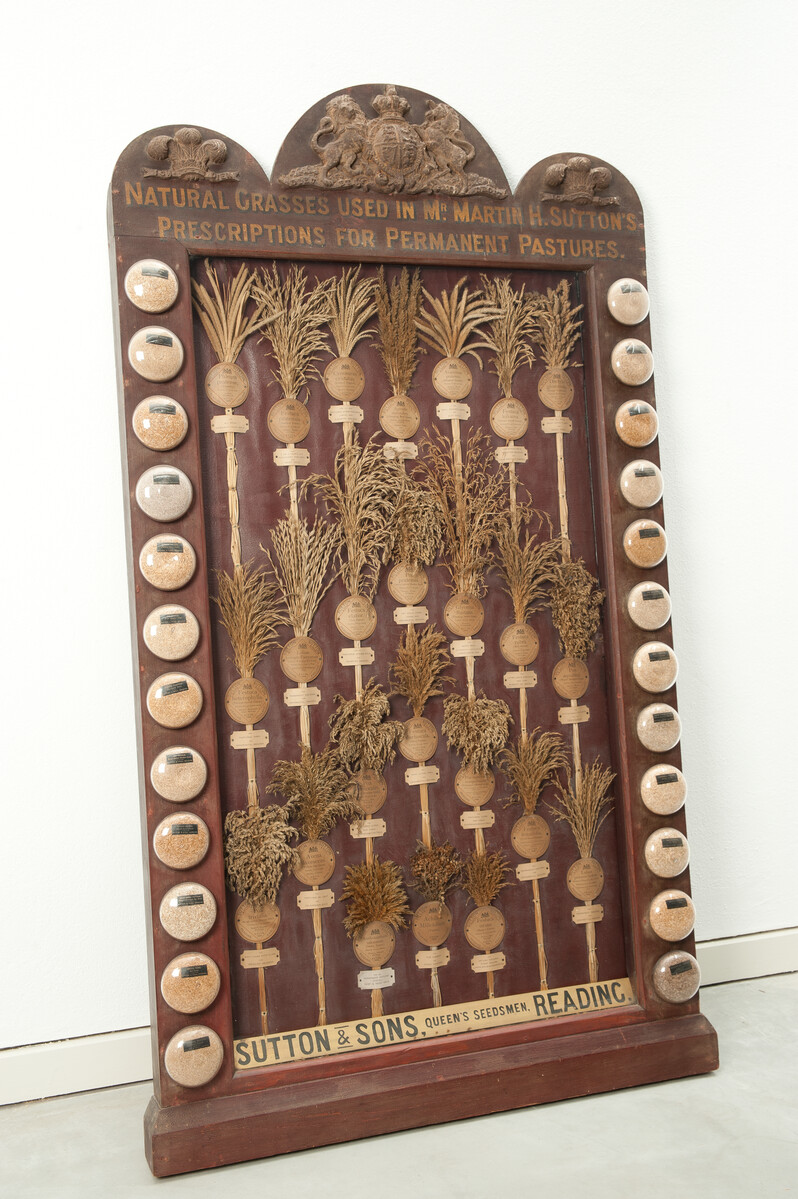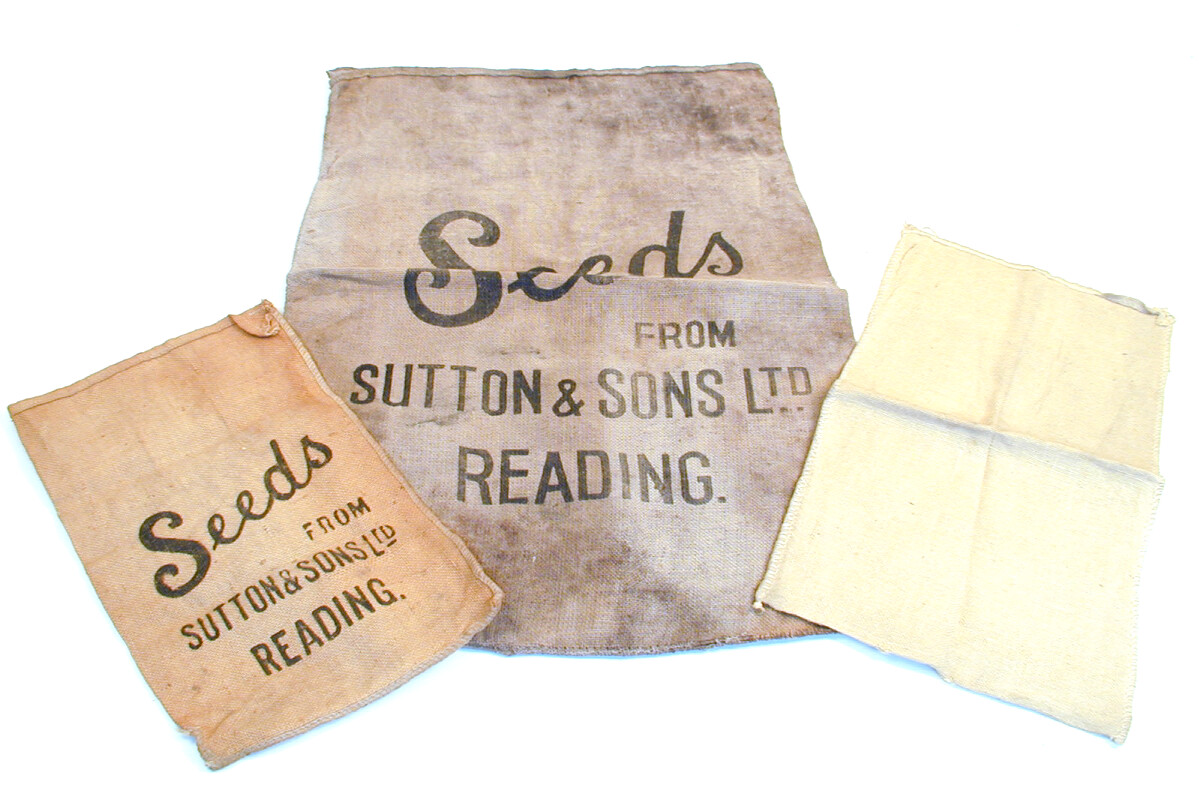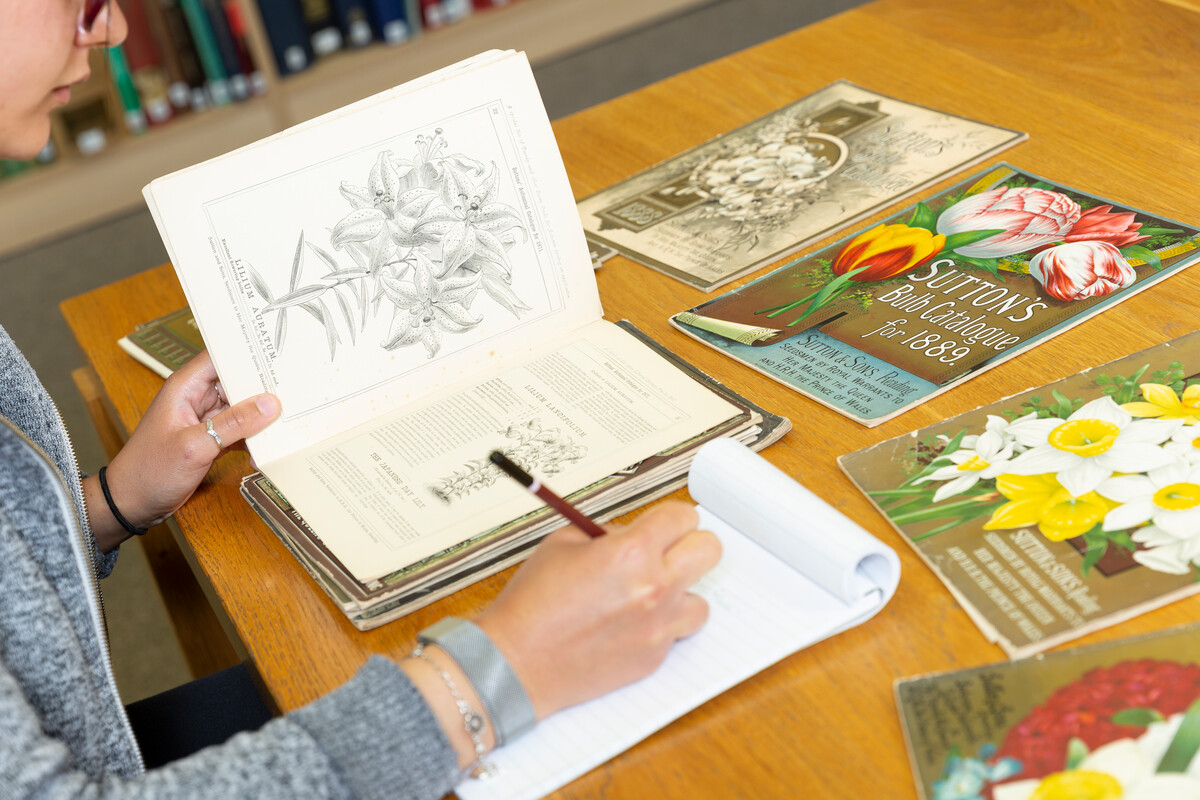The story of Suttons Seeds: 1806 – present
Written by Gaby Lawrence, Graduate Trainee Archive Assistant
Historically, Reading is known for the three Bs: biscuits, beer, and bulbs. We have also joked that this could include ‘big sheep‘, but we will let future Reading historians make the call on that.
While last year we celebrated our town’s history of biscuit-making (through the bicentenary of the founding of Huntley & Palmers), today we are looking at our town’s roots in bulbs and seeds, sewn through the work of pioneering Reading company, Suttons Seeds.
In this article, produced as part of Our Green Stories (a Museums Partnership Reading campaign exploring sustainability through collections at The MERL and Reading Museum), learn about the work and history of this pioneering firm: from its origins as a family business in Reading’s Market Place, to Suttons’ pivotal role in the wartime home front, and beyond.
The Origins of Suttons
The Suttons story began in 1806. The company was founded by John Sutton (1777-1863), a corn factor (trader) and miller with a small trade in farm seeds. John did not intend for his sons to follow him into the corn trade, but that they did. The business expanded dramatically under the stewardship of his second son, Martin Hope Sutton, who became celebrated in his lifetime as Berkshire’s most venerated entrepreneur.
Martin Sutton’s influence in the business was distinguished by his decision to move the commercial focus from corn (as well as flour, malt, and hops) to garden seeds, pursuing a ‘layman’s interest in botany’. He was warned by his father that this would not be lucrative, and that he should pursue this hobby outside of working hours. Nevertheless, Martin persisted. In 1831, he opened his first account with a London seed wholesaler. By 1832, he had drawn up his first balance sheet, and later that year he produced the company’s first ever catalogue. At the close of the year, Martin’s sisters had made 8,700 brown paper bags for packaging, and by early 1833 the seed trade was beginning to soar. Indeed, by the end of the decade, the business had moved to a new premises in the Market Place and garden seeds now accounted for 42% of stocks, which had likewise risen in value.

Quality assurance and innovation
In 1840, Suttons was leading the way in formulating policy for seed testing. The firm had established its own laboratory to test seeds for germination and purity, to ensure the highest quality of seeds for crop stand, yield, and value. Seed testing became law in 1920 through the passing of the Seeds Act, and the Suttons seed testing station became one of the first to be licensed by the Government.
In 1858, Suttons became known as Sutton & Sons and received a Royal patronage. Many of the company’s promotional materials refer to the business as ‘the Queen’s Seedsmen’. The business grew with innovations in tools and machinery, but despite advances in engines and automated modes of transport, the business kept using horses.

Suttons at the outbreak of the First World War
As Suttons & Sons continued growing into the 20th century, the outbreak of the First World War created a boom in demand for indigenous British seed production. This was because the seed industry was vital for meeting the soaring demand for home-grown vegetables. The rallying call to ‘grow your own’ remains an enduring memory of wartime Britain, and this demanded huge stores of seeds.
The seed-growing industry’s importance to the war effort was cemented in policy on 30 December 1915, when seed production was designated on the list of ‘reserved occupations vital to the war effort’. In fact, Suttons staff were even disqualified from National Service because the Board of Agriculture deemed their services so indispensable. The demand for seeds scaled to such an unprecedented height that workers grew unable to dispatch orders quickly enough. Volunteers were asked to work through the night.
Despite the radical changes of the world around them, Suttons remained a family business through and through. Like so many British families at this time, the violence and heartache of the war took a devastating toll. At the outbreak of the war, Leonard Goodhart Sutton (son of Martin Sutton) presided over the company, and he had one daughter and five sons of his own. Tragically, four of his sons did not survive the war. The family home was at Hillside, a five-minute walk from The MERL along Redlands Road. As an interesting aside, this property was leased to the Suttons by the Palmers, proprietors of Huntley & Palmers, another of Reading’s major business dynasties.

World War II and beyond
The outbreak of the Second World War recreated a dramatic need for domestic food production. The Ministry of Agriculture promoted a ‘Dig for Victory’ campaign which encouraged individuals to grow their own produce as a way of supplementing their diet during rationing. Green spaces across the country were converted into vegetable patches to help feed the nation, as the Battle of the Atlantic began with the intention of starving Britain into submission. The sudden urgent need for produce launched an immediate movement to educate the public in the ways of gardening. The Royal Horticultural Society began teaching lectures and demonstrations and produced a surplus of instructional pamphlets, and even began broadcasting gardening advice on BBC radio. The Ministry of Agriculture announced plans to create half a million allotments and announced that all free land was to be used for planting purposes and feeding the nation.
Like in the First World War, Suttons played a major role in Britain’s wartime agriculture. They began distributing seeds to the public for staple crops like carrots, parsnips, cabbage, radish and cucumber. In the introduction to their 1941 catalogue, they sought to mobilise the British Home Front by declaring that ‘it is the bounden duty of those who have the smallest space to cultivate, to do so intensively, that the brave may be fed and that the lifeline of the Atlantic be not unduly strained’.
The demands of the Home Front and the need for mass agriculture continued well beyond the end of the war. Britain had become bankrupt and unable to resume food imports at pre-war levels, thus the need for home-grown vegetables did not diminish after the war was won. In fact, conflicts during the World Wars only emphasised the importance of self-sufficiency, and triggered the Green Revolution of the 1960s and 70s.
It is the bounden duty of those who have the smallest space to cultivate, to do so intensively, that the brave may be fed and that the lifeline of the Atlantic be not unduly strained.
Introduction to the
1941 Suttons catalogue
Peacetime to the present day
In 1962, Suttons & Son once again moved to a new premises, this time on the London to Bath Road. The premises were the most modern and state-of-the-art of their kind in the UK. Suttons maintained this upwards trajectory and strived to constantly develop the horticultural industry with the times and was the first company to offer recyclable foil packets to the amateur gardener in the UK. The company moved premises twice more, first to Devon in 1976 and most recently to its current location in 1998.
Since entering the 21st century, Suttons has taken further steps to be as environmentally sustainable as possible. The company has taken major steps in recycling wherever possible and minimising plastic waste (including using paper and ‘naked’ packaging). They have made significant investments in solar power, while reducing transport emissions by growing over 1 million plants at their Devon nursery. They have halted the use of neonicotinoids (insecticide) and swapped to 100% peat free compost, while also marketing environmentally-friendly products aimed at encouraging and supporting pollinators and native British wildlife.
Now known as Suttons Seeds Ltd., the company’s records are kept at The MERL and across the University of Reading’s Special Collections. The MERL holds more than 100 objects used and made by Suttons, including sacks, signs and seeds themselves, and displays many of these throughout the galleries. The archives can be consulted by Readers (it’s free), and you can find out more on our reading room page.

Find out more
- Visit the Suttons Seeds page in our collections A-Z index
- Learn about Suttons’ colonial history in our online exhibition connecting The MERL collections to British colonialism
- Explore more from Our Green Stories and discover what’s coming up in 2023

